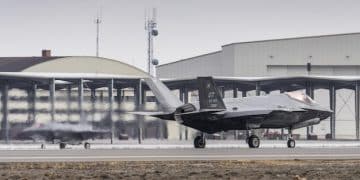US Defense Spending Up 7% in 2025: Contractor Impact

The projected 7% increase in US defense spending for 2025 will significantly reshape the landscape for US defense contractors, driving intensified competition, boosting innovation in critical technology sectors, and demanding greater operational efficiency and strategic adaptability.
The defense sector is a dynamic and ever-evolving segment of the global economy, directly influenced by geopolitical shifts, technological advancements, and governmental fiscal policies. As news of a projected 7% increase in defense spending for 2025 circulates, many in the industry, especially US defense contractors, ponder the potential ramifications. This anticipated budget hike isn’t just a number; it represents a strategic shift with profound implications for contracts, innovation, and market dynamics.
Understanding the Landscape of US Defense Spending
The United States defense budget is arguably the largest globally, reflecting its expansive national security interests, global military presence, and commitments to allies. This massive spending directly fuels thousands of companies, from multinational giants to specialized small businesses, all contributing to the intricate web of the defense industrial base. The proposed 7% increase for 2025 signals not merely a continuation but an acceleration of investment, driven by evolving threats and the imperative to maintain technological superiority.
Analyzing this increase requires a multi-faceted approach, looking beyond just the topline figure. It encompasses procurement of new weaponry, research and development (R&D) into cutting-edge technologies, sustainment of existing platforms, and personnel costs. Each category presents unique opportunities and challenges for contractors. For instance, increased R&D funding might favor specialized tech firms, while a surge in procurement directly benefits large-scale manufacturers.
Drivers of Increased Defense Expenditure
Several key factors underpin the proposed budget increase. Geopolitical tensions, particularly those stemming from ongoing conflicts and rivalries with major powers, are undeniably primary motivators. The need to deter aggression and protect national interests necessitates a robust and well-funded military. Furthermore, the rapid pace of technological change means that systems become obsolete faster, requiring continuous investment in upgrades and replacements.
- Global Geopolitical Instability: Heightened tensions in Eastern Europe, the Indo-Pacific, and the Middle East demand strengthened defense capabilities.
- Technological Race: Competition with peer adversaries in areas like AI, cyber warfare, and hypersonics requires significant R&D investment.
- Modernization Imperative: Many existing platforms require costly upgrades or replacement to remain effective against contemporary threats.
- Supply Chain Resilience: Efforts to onshore critical manufacturing and strengthen defense supply chains play a growing role in budget allocations.
These drivers create a compelling argument for increased spending, often enjoying bipartisan support in Congress due to national security concerns. For defense contractors, understanding these underlying factors is crucial for anticipating demand and aligning their capabilities with future government priorities. The clarity on these drivers allows companies to make informed strategic decisions.
Moreover, domestic economic considerations also play a role. Defense spending is often seen as an economic stimulus, creating jobs and fostering innovation within the country. While not the primary driver of defense policy, its economic impact is a significant byproduct that policy-makers consider. The interplay of these diverse factors makes the defense spending landscape complex but also rich with opportunity for savvy contractors.
Impact on Major Defense Contractors: Growth and Consolidation
The projected 7% spending increase is poised to primarily benefit the largest US defense contractors, often referred to as the “Big Five” (Lockheed Martin, Boeing, Raytheon Technologies, Northrop Grumman, and General Dynamics). These companies possess the scale, infrastructure, and established relationships to secure major contracts spanning aircraft, shipbuilding, missile defense, and advanced electronics. Their diverse portfolios allow them to capitalize on broad increases across various defense sectors.
Increased funding will likely translate into accelerated production rates for existing programs and new development contracts. For example, programs like the F-35 Joint Strike Fighter, B-21 Raider, and various naval shipbuilding initiatives could see significant boosts. This surge in demand creates a ripple effect throughout their extensive supply chains, extending opportunities to smaller, specialized suppliers who provide components and services.
Strategic Adjustments and Investment Priorities
Major contractors are not merely passive recipients of increased funds; they are active shapers of the defense industrial base. With additional funding, these companies will likely prioritize investments in areas deemed critical for future warfare, such as advanced manufacturing, digital engineering, and cybersecurity. They will also focus on enhancing their research and development capabilities to stay ahead in the technological race.
- Digital Transformation: Investing in AI, machine learning, and advanced analytics to optimize operations and product development.
- Supply Chain Fortification: Strengthening domestic supply chains and diversifying sources to mitigate risks and improve resilience.
- Talent Acquisition: Recruiting and retaining top engineering and technical talent to support complex programs.
- Mergers and Acquisitions: Potentially acquiring smaller, innovative firms to gain access to niche technologies or expanded capabilities.
These strategic investments are crucial for major contractors to maintain their competitive edge and continue securing large government contracts. The scale of these investments often requires significant capital, which larger firms are better positioned to provide. Consequently, smaller companies must align their offerings with these strategic priorities to become attractive partners or acquisition targets.
Furthermore, larger contractors often serve as prime integrators, managing complex systems involving numerous subcontractors. An increase in overall spending means more prime contracts, which in turn generates more work for the broader ecosystem of defense suppliers. This amplifies the economic impact of the budget increase, distributing capital throughout the industry and across different regions of the country. The demand for robust program management and seamless integration will only grow.

Opportunities for Small and Medium-Sized Enterprises (SMEs)
While large primes often capture headlines, the defense industrial base relies heavily on a robust network of small and medium-sized enterprises (SMEs). These companies are frequently the source of specialized components, niche technologies, and innovative solutions that are critical to advanced defense systems. The 7% spending increase offers significant, albeit sometimes indirect, opportunities for SMEs.
Many SMEs operate as subcontractors to larger primes, providing everything from precision machining and specialized electronics to software development and consulting services. As prime contractors receive more funding and new project awards, the demand for these subcontracted services and components will naturally rise. This trickle-down effect is vital for the health and innovation capability of the entire defense ecosystem.
Navigating the Subcontracting Landscape
For SMEs, success often hinges on their ability to integrate into the supply chains of larger contractors. This requires not only technical excellence but also adherence to stringent defense standards, robust quality control, and often, significant investment in compliance. Building strong relationships with prime contractors is essential, as these often lead to long-term partnerships and repeat business.
- Specialized Niche Technologies: Focusing on unique capabilities in areas like advanced materials, cybersecurity, or specific software solutions.
- Agility and Adaptability: Being able to pivot quickly to meet evolving defense requirements and technology demands.
- Compliance Expertise: Demonstrating thorough understanding and adherence to defense regulations (e.g., CMMC, ITAR).
- Innovation Partnerships: Collaborating with universities or research institutions to develop cutting-edge technologies that can be integrated into larger defense programs.
Government initiatives, such as the Small Business Innovation Research (SBIR) and Small Business Technology Transfer (STTR) programs, are also key avenues for SMEs to directly access defense funding. An overall budget increase typically means more funding for these programs, enabling small businesses to develop and commercialize technologies with military applications. These programs are designed to foster innovation and help smaller businesses bridge the gap between initial research and full-scale production.
Furthermore, the drive for enhanced supply chain resilience means that the Department of Defense (DoD) is actively seeking to diversify its supplier base. This creates openings for new SMEs to enter the market, especially those that can offer domestic manufacturing capabilities or address critical vulnerabilities in existing supply chains. The emphasis on mitigating risks through diversification presents a strategic advantage for agile smaller firms.
Focus on Critical Technologies and Innovation
A significant portion of the increased defense spending is earmarked for critical technologies that promise to redefine future warfare. Areas such as artificial intelligence (AI), machine learning (ML), hypersonics, cybersecurity, quantum computing, and advanced materials will receive substantial investment. This focus isn’t just about incremental improvements; it’s about revolutionary capabilities that can provide a decisive edge.
Defense contractors, both large and small, that are positioned at the forefront of these technological advancements stand to gain immensely. The demand for expertise in these fields will intensify, leading to increased R&D contracts, prototyping opportunities, and ultimately, production contracts for systems incorporating these technologies. This creates a highly competitive environment for innovation.
Key Investment Areas and Emerging Sectors
The Department of Defense has clearly articulated its priorities regarding technological superiority. Contractors must align their research and development efforts with these strategic imperatives to secure future contracts. This often involves significant internal investment, as well as fostering partnerships with academic institutions and specialized tech startups.
- Artificial Intelligence & Machine Learning: For autonomous systems, data analysis, predictive maintenance, and decision support.
- Cyber Warfare & Security: Developing offensive and defensive capabilities to protect critical infrastructure and systems.
- Hypersonic Technologies: Advancing propulsion, materials, and strike capabilities for high-speed flight.
- Space-based Capabilities: Enhancing satellite communication, surveillance, and missile defense systems.
- Directed Energy Weapons: Research into laser and high-power microwave systems for various applications.
The emphasis on rapid prototyping and agile development methodologies will also shape how these technologies are brought to market. The DoD is increasingly looking to reduce acquisition timelines and incorporate new innovations more quickly. This benefits contractors who can demonstrate flexibility and efficiency in their development processes, moving away from protracted program cycles.
Furthermore, the push for digital engineering and model-based systems engineering (MBSE) will continue to gain traction. These approaches aim to streamline design, testing, and production, ultimately reducing costs and accelerating development. Contractors with strong capabilities in these areas will be highly sought after. Embracing digital transformation is no longer optional but a strategic imperative to remain competitive within the defense sector.
Challenges for US Contractors in a Buoyant Market
While a 7% increase in defense spending presents clear opportunities, it also amplifies existing challenges and introduces new ones for US contractors. A buoyant market can lead to intense competition, skilled labor shortages, and increased scrutiny over cost and performance. Companies must navigate these complexities strategically to truly benefit from the budget hike.
One primary challenge is the heightened demand for a specialized workforce. Engineers, cybersecurity experts, data scientists, and skilled tradespeople are already in high demand. The increased spending will exacerbate these shortages, potentially leading to higher labor costs and difficulties in recruiting and retaining talent. Contractors will need robust talent pipelines and competitive compensation packages.
Operational and Strategic Hurdles
Even with more funding available, defense contracting remains a tightly regulated and highly competitive environment. Companies must not only demonstrate technical proficiency but also operational excellence, cost efficiency, and unwavering compliance with government regulations. The stakes are incredibly high, and mistakes can be costly.
- Talent Acquisition and Retention: Competing for scarce skilled labor in highly technical fields.
- Supply Chain Volatility: Managing disruptions and vulnerabilities in global and domestic supply chains.
- Regulatory Compliance: Adhering to evolving cybersecurity, export control (ITAR), and other complex government regulations.
- Cost Efficiency and Performance: Meeting demanding performance requirements while staying within budget constraints.
The pressure to innovate rapidly while delivering reliable and cost-effective solutions will also intensify. The DoD is pushing for greater efficiency and value, meaning contractors must focus on lean manufacturing, digital transformation, and smart procurement strategies. Simply winning more contracts isn’t enough; delivering on them profitably and on time is paramount. This environment demands continuous improvement.
Moreover, the geopolitical landscape introduces its own set of challenges, including the need for heightened security measures, adapting to evolving export controls, and managing risks associated with international partnerships. Contractors operating internationally must stay abreast of complex political dynamics that can impact their operations and market access. The need for robust risk management strategies cannot be overstated.

Geographic Distribution and Economic Ripple Effects
The impact of increased defense spending is far from uniform across the United States. Certain states and regions with a high concentration of defense contractors, military bases, or specialized industries will experience more pronounced economic ripple effects. This geographic distribution is a crucial aspect of understanding the overall impact on US contractors.
States like Virginia, California, Texas, Florida, and Maryland, which house major defense industry hubs and significant military installations, are likely to see substantial benefits. These regions often have established ecosystems of large primes, numerous SMEs, and a skilled labor pool, making them prime locations for new investments and contract awards. The jobs created span a wide range of skills, from engineering and manufacturing to administrative and support roles.
Regional Economic Boosts and Local Impact
Beyond direct employment, increased defense spending stimulates local economies through indirect and induced effects. Contractors purchase goods and services from local businesses, employees spend their wages in the community, and tax revenues may increase. This multi-layered economic activity can significantly boost regional growth.
- Job Creation: Direct employment in defense firms and indirect jobs in supporting industries.
- Research & Development Hubs: Concentration of R&D funding in regions with strong university and industry partnerships.
- Infrastructure Investment: Potential for upgrades in R&D facilities, manufacturing plants, and related infrastructure.
- Small Business Support: Growth opportunities for local suppliers and service providers catering to defense contractors.
The specialization of certain regions also plays a role. For instance, areas known for shipbuilding (e.g., Virginia, Mississippi) or aerospace manufacturing (e.g., Washington, California) will likely see particular boosts in those specific sectors. Companies located in these clusters are better positioned to capitalize on direct contracts or subcontracting opportunities related to their expertise. Regional development strategies often align with these defense spending patterns.
However, this also means that regions without a strong defense industrial base might not experience the same level of direct economic benefit. While the national economy as a whole receives a boost, the distribution of wealth and jobs can be concentrated. Understanding these geographic dynamics is vital for contractors considering expansion or for policymakers aiming to spread economic benefits more evenly. The competitive advantage often lies in the existing infrastructure and talent pools present in established defense corridors.
Looking Ahead: Adaptability and Long-Term Strategy
The projected 7% increase in defense spending for 2025 is a significant, yet singular, event within a long-term strategic continuum. For US defense contractors, short-term gains must be viewed through the lens of long-term sustainability and adaptability. The industry is characterized by cycles of expansion and contraction, driven by shifting geopolitical priorities and technological paradigms.
Contractors must not only capitalize on immediate opportunities but also strategically position themselves for future challenges and changes. This involves continuous investment in R&D, fostering a culture of innovation, and diversifying capabilities where appropriate. Those who remain agile and forward-thinking will be best equipped to thrive in this dynamic environment.
Future-Proofing the Defense Industrial Base
The emphasis on future-proofing extends beyond technological readiness. It includes developing resilient supply chains, investing in human capital, and maintaining a robust ethical and compliance framework. The lessons learned from recent global events underscore the importance of self-sufficiency and strategic autonomy in critical defense sectors.
- Continuous Innovation: Prioritizing R&D in emerging and disruptive technologies to stay ahead of adversaries.
- Talent Development: Investing in training, education, and career development to build and maintain a skilled workforce.
- Diversification: Exploring adjacent markets or civilian applications for defense technologies to reduce dependency on government contracts.
- Strategic Partnerships: Collaborating with other companies, universities, and government agencies to share risks and accelerate development.
Moreover, environmental, social, and governance (ESG) factors are increasingly becoming important considerations for defense contractors, both from an investor perspective and in terms of public perception. Implementing sustainable practices and demonstrating corporate responsibility can enhance reputation and attract a broader talent pool, contributing to long-term resilience. Responsible corporate behavior is becoming a non-negotiable aspect of doing business.
Ultimately, the ability of US defense contractors to translate a 7% spending increase into sustained growth and enhanced national security capabilities will depend on their strategic foresight and operational excellence. It’s an opportunity to reinforce America’s defense posture while simultaneously strengthening its industrial and technological base. The challenges are substantial, but the potential rewards are equally significant for those prepared to meet the moment.
| Key Point | Brief Description |
|---|---|
| 🚀 Increased Funding | A 7% boost in defense spending for 2025 will significantly increase contract opportunities. |
| 💡 Tech Innovation | Emphasis on AI, cyber, hypersonics drives R&D and specialized tech contracts. |
| 🔗 Supply Chain Impact | Ripple effects benefit SMEs as subcontractors, strengthening the industrial base. |
| 👨💻 Workforce Demands | Increased demand for specialized talent creates recruitment and retention challenges. |
Frequently Asked Questions About Defense Spending Impacts
A 7% increase means a significant boost in the overall budget available for procurement, research, and sustainment. This directly translates to a higher volume of new contracts and expanded scopes for existing ones, benefiting both prime and sub-contractors across various defense sectors.
Yes, small businesses will benefit from increased subcontracting opportunities with major primes. Additionally, programs like SBIR/STTR, designed to support small business innovation, are likely to see enhanced funding, creating more direct contracting pathways for SMEs.
Significant investment is anticipated in critical technologies such as artificial intelligence, cybersecurity, hypersonics, quantum computing, and advanced materials. These areas are central to maintaining a strategic advantage and modernizing defense capabilities for future conflicts.
Contractors might face challenges including intensified competition, shortages of skilled labor, and stringent regulatory compliance requirements. Managing supply chain volatility and maintaining high cost-efficiency will also be critical to securing and retaining contracts.
Adaptability is paramount. Contractors must continually invest in R&D, develop resilient supply chains, and foster a culture of innovation to navigate evolving threats and technological shifts. Strategic agility ensures long-term sustainability beyond immediate budget increases.
Conclusion
The projected 7% increase in US defense spending for 2025 marks a pivotal moment for defense contractors. It signals a robust commitment to national security and technological superiority, translating into substantial opportunities for growth, innovation, and strategic expansion across the industry. While large primes are poised to secure major contracts, the ripple effect will undoubtedly extend to small and medium-sized enterprises, particularly those specializing in critical technologies. However, this growth is not without its challenges, including heightened competition, the imperative for rapid innovation, and a demanding talent landscape. For contractors to truly thrive, a strategic blend of technological foresight, operational excellence, and an unwavering commitment to compliance will be essential, ensuring that the enhanced budget effectively strengthens the nation’s defense capabilities and sustains a vibrant industrial base.





